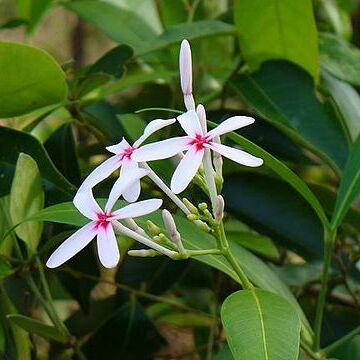Trees or shrubs with white latex. Leaves opposite. Cymes terminal, 3-to many flowered, bracteate; peduncle long or short; bracteoles small or large. Flowers white or rose, 5-merous. Calyx small, deeply divided, without glands. Corolla salverform, tube 2.3-5 cm, narrow, dilated at or below apex; throat without scales, pilose inside; lobes overlapping to right. Stamens inserted above middle of corolla tube; filaments very short; anthers narrowly oblong or ovate, included, free from pistil head, base rounded; disc scales alternate with ovaries. Ovaries 2, distinct; ovules 2 per locule. Style filiform; pistil head thickened, with a short basal collar and apiculate apex. Drupes 1 or 2, ellipsoid, 1-or 2-seeded. Seeds oblong, testa membranous, not comose.
Perennial shrubs or trees, evergreen; latex white. Stems without spines. Leaves opposite, petiolate; lamina entire, herbaceous to coriaceous, glabrous; colleters absent. Inflorescence terminal, cymose, pedunculate. Flowers scented, pedicellate. Calyx without colleters. Corolla salverform; tube cylindrical, widened at top, glabrous, without scales; lobes dextrorse in bud. Corolline corona absent. Stamens included, inserted in upper part of tube, not adherent to style-head; anthers lanceolate. Disc of 2 scales alternating with ovaries. Style-head conical with a basal flange. Fruit apocarpous, drupaceous, ovoid to ellipsoidal, with a ventral wing. Seed solitary, unwinged, ecomose.

